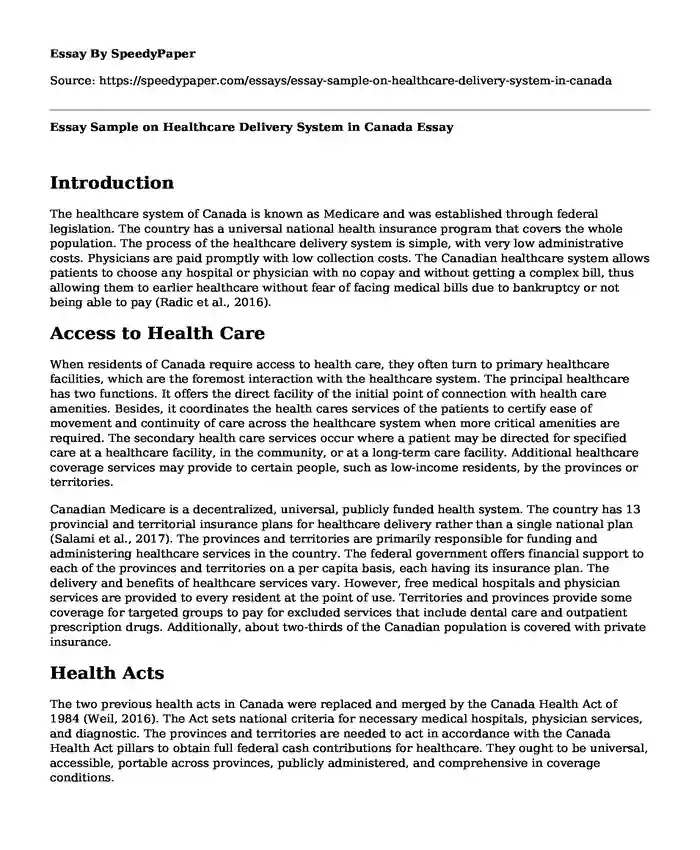
| Type of paper: | Essay |
| Categories: | Health and Social Care World |
| Pages: | 3 |
| Wordcount: | 700 words |
Introduction
The healthcare system of Canada is known as Medicare and was established through federal legislation. The country has a universal national health insurance program that covers the whole population. The process of the healthcare delivery system is simple, with very low administrative costs. Physicians are paid promptly with low collection costs. The Canadian healthcare system allows patients to choose any hospital or physician with no copay and without getting a complex bill, thus allowing them to earlier healthcare without fear of facing medical bills due to bankruptcy or not being able to pay (Radic et al., 2016).
Access to Health Care
When residents of Canada require access to health care, they often turn to primary healthcare facilities, which are the foremost interaction with the healthcare system. The principal healthcare has two functions. It offers the direct facility of the initial point of connection with health care amenities. Besides, it coordinates the health cares services of the patients to certify ease of movement and continuity of care across the healthcare system when more critical amenities are required. The secondary health care services occur where a patient may be directed for specified care at a healthcare facility, in the community, or at a long-term care facility. Additional healthcare coverage services may provide to certain people, such as low-income residents, by the provinces or territories.
Canadian Medicare is a decentralized, universal, publicly funded health system. The country has 13 provincial and territorial insurance plans for healthcare delivery rather than a single national plan (Salami et al., 2017). The provinces and territories are primarily responsible for funding and administering healthcare services in the country. The federal government offers financial support to each of the provinces and territories on a per capita basis, each having its insurance plan. The delivery and benefits of healthcare services vary. However, free medical hospitals and physician services are provided to every resident at the point of use. Territories and provinces provide some coverage for targeted groups to pay for excluded services that include dental care and outpatient prescription drugs. Additionally, about two-thirds of the Canadian population is covered with private insurance.
Health Acts
The two previous health acts in Canada were replaced and merged by the Canada Health Act of 1984 (Weil, 2016). The Act sets national criteria for necessary medical hospitals, physician services, and diagnostic. The provinces and territories are needed to act in accordance with the Canada Health Act pillars to obtain full federal cash contributions for healthcare. They ought to be universal, accessible, portable across provinces, publicly administered, and comprehensive in coverage conditions.
Generally, the quality of healthcare ranking in Canada is still among the best worldwide. Almost every Canadian has a primary care doctor with proper health outcomes. The Medicare systems of Canada are cost-effective due to their administrative simplicity. The need for care tends to grow stronger as one grows older. The health system is effective and equitable since it covers all Canadian residents.
The universal system of healthcare in Canada may be regarded as an alternative superior model for the United States. The United States has a multi-payer system that is privately funded, while the single-payer system of Canada is publicly funded. In Canada, health care coverage is not dependent on individual income as in the United States. Canada spends far less of the gross domestic product on Medicare compared to that of the United States.
Conclusion
The healthcare delivery system of Canada is governed by the legal framework and basic principles established by the federal government. Federal legislation ensures that all residents get access to needed Medicare financed by tax revenues. Regardless of income, every resident is entitled to hospital and medical services. The basic characteristics of the healthcare system of Canada are that it covers all residents equally.
References
Ridic, G., Gleason, S., & Ridic, O. (2016). Comparisons of health care systems in the United States, Germany, and Canada.
https://www.ncbi.nlm.nih.gov/pmc/articles/PMC3633404/.
Salami, B., Nelson, S., Hawthorne, L., Muntaner, C. & Hall, L. M. (2017). Motivations of nurses who migrate to Canada as domestic workers. International Nursing Review, 61(4), pp. 479-486.
https://doi:10.1111/inr.12125
Weil, T. P. (2016). The Canadian healthcare system: It needs enhancement. Health Services Management Research, 29(4), 107–114.
https://doi.org/10.1177/0951484816673668.
Cite this page
Essay Sample on Healthcare Delivery System in Canada. (2023, Dec 12). Retrieved from https://speedypaper.com/essays/essay-sample-on-healthcare-delivery-system-in-canada
Request Removal
If you are the original author of this essay and no longer wish to have it published on the SpeedyPaper website, please click below to request its removal:
- Free Essay on Orem's Model and Diet in Obese Patients with DMtype 2
- Check the Settings for Public Health in Our Free Essay
- Dr. Meleis' Transitions Theory, Nursing Essay Example
- Paper Example on Mental Health of Transgender Children
- Paper Example. Environmental Public Health Policy
- Paper Example on Policy on Infection Control and Surgical Procedures
- Essay Sample on Hospital Subsector: Crucial to National & Local Economies, Quality of Life
Popular categories




